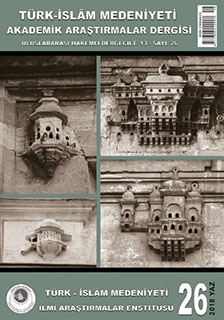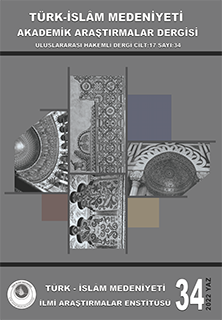Şanlıurfa Ulu Cami Graveyard Poems in Grave Stones
Keywords:
Grave, poem, literatüre, The Ulu Mosque, SanliurfaAbstract
Throughout history, every society has different religious beliefs. These beliefs have very important effects on that society. Dead burial and burial tradition are the rituals of these beliefs. With the acceptance of the Islam of the Turks, the dead burial and the tomb tradition have progressed to the present day with very important stages. Cemeteries and tombstones belonging to the Ottoman era have attracted the interest of researchers both the artistic direction and the architectural style, as well as carrying a title character for Anatolia. The inscriptions on these grave stones have been the subject of art and aesthetics both in terms of their writing and in their construction. The very fine stone workmanship they have, the titles in different forms, the literary expressions they carry, the poems which are important for Divan Literature and the beautiful examples of the writing art make these stones very valuable. Sanliurfa, which produced a poet like Nabi in the field of Turkish Literature, grew many poets such as Abdi, Şevket, Mihri and Kıratoğlu Emîn, who had poetry not so strong but poetically enough to form a religious order. The poems taken by these poets are processed into tombstones. In this article, we will try to prepare these poems, which are thought to be valuable for Divan literature, to be used for contemporary researchers.
References
ALPAY, B., 1986, “Şanlıurfa Şairleri I”, Dal Yayıncılık, Şanlıurfa 1986.
BEKTAŞ, E., 2008, “Urfalı Şair Hilmî ve Reyâhîn’i”, Şanlıurfa Valiliği İl Kültür ve Turizm Müdürlüğü Yayınları, Şanlıurfa.
______, 2008, “Urfalı Hilmî’nin Antep Günleri”, Uluslararası Gaziantep Araştırmaları (Sözlü Kültür, Dil ve Edebiyat), Gaziantep Üniversitesi Fen Edebiyat Fakültesi, Türk Dili ve Edebiyatı Bölümü, 10-12 Nisan 2008, Gaziantep.
______, 2009, “İstanbul’da Taşralı Bir Şair”, Beykent Üniversitesi, I. Uluslararası Türk Edebiyatında İstanbul Sempozyumu Bildirileri, (3-5 Nisan 2008, İstanbul), Beşir Kitabevi, İstanbul.
______, 2006, “Urfalı Şair Hilmî ve Kayıp Eseri Reyâhîn” EKEV Akademi Dergisi, Yıl: 10, Sayı: 26, Erzurum Kış 2006.
BERK, S., 2006, “Zeytinburnu’nun Mezar Taşları, Zamanı Aşan Taşlar”, Zeytinburnu Belediyesi Yay., İstanbul.
DÖRTBUDAK, M. V., 2003, “Kıratoğlu Emin Divanı”, Akademik Kitabevi, İzmir.
______, 2006, “Geleneğin Direnen Şairi; Kıratoğlu Emin Fırakiyyesinden Birkaç Şiir”, Klasik Türk Edebiyatı Sempozyumu (Prof. Dr. Abdulkadir Karahan’a Armağan), Şanlıurfa Belediyesi Yayınları, Şanlıurfa.
GÜLER, G., 2015, “Urfa Ulu Camii Haziresindeki Mezar Taşları”, Türk-İslam Medeniyeti Akademik Araştırmalar Dergisi, Yıl 10, Sayı 20, Konya 2015.
GÜLER, M., 2005, “XII. Yüzyıl Anadolu Türk Camileri”, Yayınlanmamış Doktora Tezi, (Danışman: Doç. Dr. İlknur Aktuğ Kolay), İTÜ Fen Bilimleri Enstitüsü, 2005.
KARABEY, T., 2011, “Tarih Düşürme”, DİA, XL/80-82, İstanbul.
KARAHAN, A., 1991, “Urfalı Mehmed Şevket ve Şiirleri”, Şanlıurfa Belediyesi Yayınları, Ankara.
KARAMAĞARALI, B., 1992, “Ahlat Mezar Taşları”, Kültür Bakanlığı Yay., Ankara.
TANPINAR, A. H., 1992, “Beş Şehir”, Milli Eğitim Bakanlığı Yay., İstanbul.
Downloads
Published
How to Cite
Issue
Section
License

This work is licensed under a Creative Commons Attribution-NonCommercial 4.0 International License.







